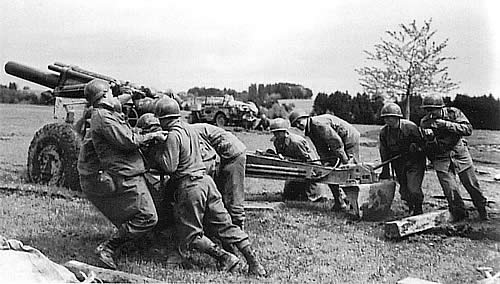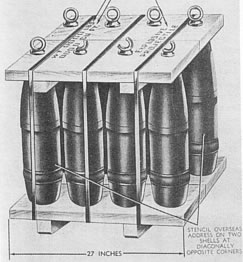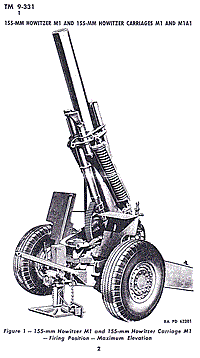Background on the 155mm Howitzer

"I
don't have to tell you who won the war," said General George
S. Patton. "You know our artillery did." Indeed, artillery
was a vital component of U.S. military tactics during WWII, whether
pounding down the enemy prior to an attack, or staving off enemy
assaults. Artillery was crucial to the successful defense of Bastogne
during the Battle of the Bulge (Brigadier General Anthony MacAuliffe
was commander of the 101st Airborne's artillery). Each infantry
division had four field artillery battalions. The battalion HQ was
equipped with three batteries each possessing 4 155mm howitzers.
The other three light artillery battalions had a combined strength
of 54 105mm howitzers.
Development
of the 155mm Howitzer M1 began in the late 1930s, when the U.S.
Army determined it needed a new medium field artillery piece to
replace the WWI vintage Howitzer M1917. The new howitzer proved
to be "one of the best field artillery weapons of its class
in WWII," according to Konrad F. Schreier, Jr. in Standard
Guide to U.S. World War II Tanks and Artillery, a primary reference
source for my project. The carriage and recoil of the 155 was also
used for the 4.5 inch Gun M1, which was not very popular. The howitzer
first saw action in North Africa in 1942.
 The
155 used "separate loading" ammunition comprised of four
components: a projectile, a separate bagged propellant charge, a
fuse and a primer. The propelling charge contained individual bags
of powder, which could be reduced to adjust for range of fire. Projectiles
were shipped in crates or pallets; the charge was packaged individually
in fibre or metal canisters. The projectiles, weighing 95 lbs. each,
had rings in the tip to assist in shipping; these were removed and
replaced with fuses when ready to fire. The primers were placed
in the breech of the gun for firing. Schreier states the 155mm howitzer
typically fired 80% or more HE (high explosive) shells during the
war. The piece could also fire smoke or white phosphorus shells
as well. The 155mm Gun M1, aka "Long Tom", and the M12
Gun Motor Carriages also used this ammunition. The
155 used "separate loading" ammunition comprised of four
components: a projectile, a separate bagged propellant charge, a
fuse and a primer. The propelling charge contained individual bags
of powder, which could be reduced to adjust for range of fire. Projectiles
were shipped in crates or pallets; the charge was packaged individually
in fibre or metal canisters. The projectiles, weighing 95 lbs. each,
had rings in the tip to assist in shipping; these were removed and
replaced with fuses when ready to fire. The primers were placed
in the breech of the gun for firing. Schreier states the 155mm howitzer
typically fired 80% or more HE (high explosive) shells during the
war. The piece could also fire smoke or white phosphorus shells
as well. The 155mm Gun M1, aka "Long Tom", and the M12
Gun Motor Carriages also used this ammunition.
 Over
4,000 of these guns were produced. A second version issued in 1944
and designated the M1A1, was made with strengthened steel and the
brakes changed from electrical to air brakes. The howitzer had a
range of 16,000 yards, more than 3,000 yards farther than the M1917.
The standard prime mover for the 155 was the Diamond T truck, but
the M5 High Speed Tractor was also used when available. Over
4,000 of these guns were produced. A second version issued in 1944
and designated the M1A1, was made with strengthened steel and the
brakes changed from electrical to air brakes. The howitzer had a
range of 16,000 yards, more than 3,000 yards farther than the M1917.
The standard prime mover for the 155 was the Diamond T truck, but
the M5 High Speed Tractor was also used when available.
The
155mm soldiered on through WWII, Korea and Vietnam; a new carriage,
the M1A2 with a screw jack, appeared after WWII. During the Cold
War, nuclear projectiles were developed for the howitzer and it
became a key part of the U.S. arsenal of deterrence in Europe. Many
of the gun tubes were changed out in the mid 1980s, and most of
the guns found today at VFW posts reflect these post-WWII alterations.
Introduction
Background
on the 155mm Howitzer
Overview
of the Model and References
Building
the Howitzer Assembly
Building the
Carriage Assembly
Painting and
Accessories
Pictures
from the Technical Manual
155mm
Ammunition
Pictures
of Museum 155mm Howitzer
Diorama:
"Mail Call for the Sons of Thor"
|












